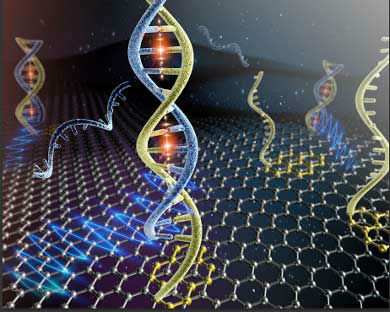|
NOVIDADES
Leiden and Jülich researchers discovered an elegant and simple approach to improve the sensitivity of graphene biosensors. These so-called ‘next generation graphene electronic biochemical sensor devices’ are able to detect very low amounts of HIV DNA thanks to their very low electronic noise.  Artist's illustration of a fraction of complementary HIV DNA molecules binding to PNA molecules that are noncovalently anchored on the graphene surface. The sine wave represents the sensing signal from the molecules being amplified by the low-noise graphene electronic sensor. Credits: Leiden University
'Over the past years, we have been focused on harvesting the unique physical and chemical properties that graphene offers for the development of versatile electronic sensor devices. The creation of practical graphene electronic sensors, however, greatly depends on our ability to understand and maintain a low level of electronic noise. And we believe that it is the fundamental reason limiting the sensor resolution,' Wangyang Fu says. Fu is a senior researcher at the Leiden Institute of Chemistry and recipient of a NWO Veni grant and an APM grant from SNF. ’Such minimization in the electronic noise can be achieved with uncompromised sensing response, and thus significantly improves the signal-to-noise ratio – compared to that of a conventionally operated graphene transistor for conductance measurement,’ Fu explains. ‘A single-stranded PNA molecule – a synthetic variant of DNA – is first noncovalently anchored on the graphene surface with a pyrene linker group. Then a complementary DNA-strand can bind. We can detect this hybridization event very sensitively at a very low noise level,’ co-authors Lingyan Feng and Dirk Mayer said. Leiden University. Posted: Oct 27, 2017. Assuntos Conexos: |
|||||||||||||||||||||||||